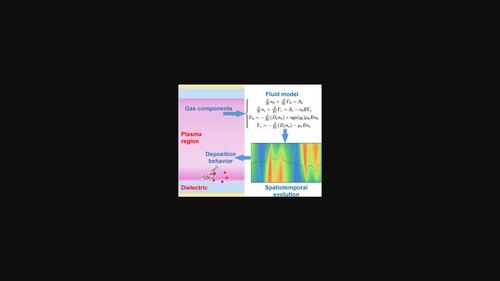Spatiotemporal evolution and its impact on the deposition behavior of atmospheric TEOS/O2/Ar plasma: A numerical study
IF 2.9
3区 物理与天体物理
Q2 PHYSICS, APPLIED
引用次数: 0
Abstract
Atmospheric dielectric barrier discharge (DBD) is a promising approach for large-area deposition, whose spatiotemporal evolution determines the deposition rate and film chemistry. To investigate the relationship between the discharge and deposition behavior of tetraethoxysilane/oxygen/argon (TEOS//Ar) DBD, a one-dimensional (1D) fluid model was constructed and experimentally verified. The calculation results reveal that TEOS mainly affects the discharge behavior via Penning ionization, while mainly affects discharge via attachment reaction. Penning ionization reduces the excited Ar and the attachment reaction reduces the number of discharges in half voltage cycles. As a result, merely increasing the concentration of TEOS or may not proportionally increase the deposition rate of relevant reactive species.

时空演变及其对大气 TEOS/O2/Ar 等离子体沉积行为的影响:数值研究
大气介质阻挡放电(DBD)是一种很有前景的大面积沉积方法,其时空演变决定了沉积速率和薄膜化学性质。为了研究四乙氧基硅烷/氧/氩(TEOS/O2${\text{O}}_{2}$/Ar)DBD 的放电和沉积行为之间的关系,我们构建了一个一维(1D)流体模型,并进行了实验验证。计算结果表明,TEOS 主要通过潘宁电离影响放电行为,而 O2${text{O}}_{2}$ 主要通过附着反应影响放电。潘宁电离减少了激发 Ar,而附着反应则减少了半电压周期内的放电次数。因此,仅仅增加 TEOS 或 O2${text{O}}_{2}$ 的浓度可能无法成比例地提高相关活性物种的沉积速率。
本文章由计算机程序翻译,如有差异,请以英文原文为准。
求助全文
约1分钟内获得全文
求助全文
来源期刊

Plasma Processes and Polymers
物理-高分子科学
CiteScore
6.60
自引率
11.40%
发文量
150
审稿时长
3 months
期刊介绍:
Plasma Processes & Polymers focuses on the interdisciplinary field of low temperature plasma science, covering both experimental and theoretical aspects of fundamental and applied research in materials science, physics, chemistry and engineering in the area of plasma sources and plasma-based treatments.
 求助内容:
求助内容: 应助结果提醒方式:
应助结果提醒方式:


